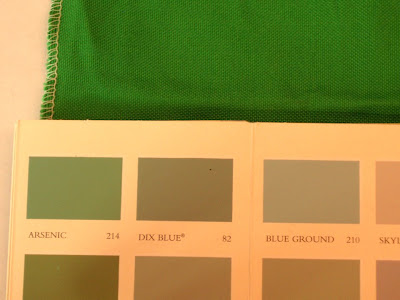Posts from the ‘elsie de wolfe’ Category
 Above is a much published photo c 1890 of Elsie de Wolfe in her Turkish Room at 49 Irving Place, NYC. This is the essential before shot; before she became a decorator; before the new century. It was the ending of the Victorian Age and she was at the end of her acting career. She was going to have to do something.
Above is a much published photo c 1890 of Elsie de Wolfe in her Turkish Room at 49 Irving Place, NYC. This is the essential before shot; before she became a decorator; before the new century. It was the ending of the Victorian Age and she was at the end of her acting career. She was going to have to do something.  In this before picture, she had not yet decorated 49 Irving Place, which helped to jump start her path (nothing new is what she said of decorating; woman have always done it). In the before photo she is in her late 30’s and living the Sapphic life and by 1905 at 40– she had received her first commission and off she went– and that, as they say, was that.
In this before picture, she had not yet decorated 49 Irving Place, which helped to jump start her path (nothing new is what she said of decorating; woman have always done it). In the before photo she is in her late 30’s and living the Sapphic life and by 1905 at 40– she had received her first commission and off she went– and that, as they say, was that.
Elsie, I’m almost overwhelmed with a lack of words to describe this image. Elsie, the gilt! Never again will this be done so well. Is this your in-town home at 10 Avenue d’Iena or is it Villa Trianon, Versailles?
“Throughout this period, the decorator became identified with conspicuous connoisseurship through the adoption of extravagant bibelots, particularly crystal obelisks and miniature jade and crystal animals. Her embrace of these, rather than Giacometti sculptures and Neo-Romantic paintings, further served to distance her from the interiors du jour of her contemporaries.
These treasures–including a small 18th-century gold-and-diamond coach and a magnificent crystal ship in full sail–were frequently used as centerpieces on her dining table”(257, Sparke).
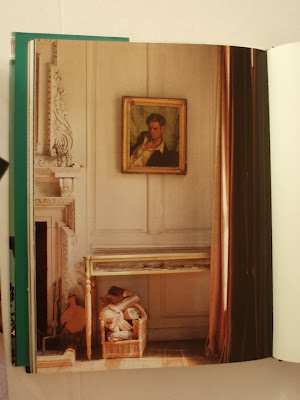 3.
3.
 4.
4.
 5.
5.
 6.
6.

7.
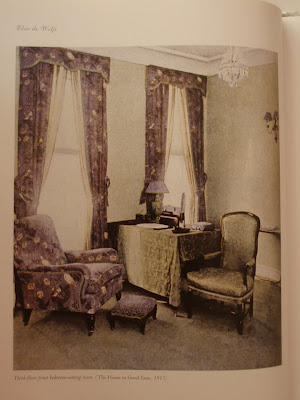
8.
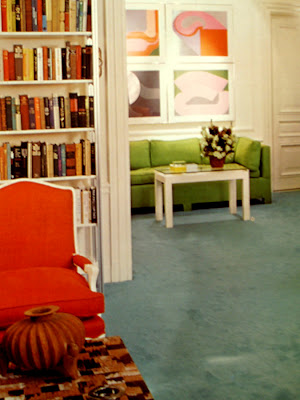 9.
9.

10.

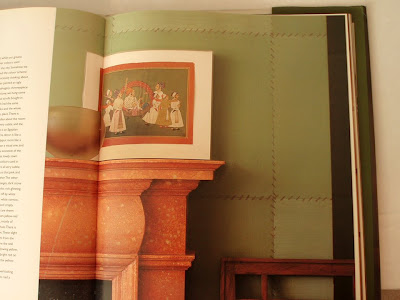
1. Farrow & Ball Arsenic my favorite color for the week–could be a fun play with Isaac Mizrahi’s “Extra silk” for S. Harris.
2. The dining room at Biddesden in Wiltshire. Lunch Green from from Farrow & Ball’s “Paint & Color in Decoration.” A must read for painting techniques & brushwork–something to study in our spray on orange peel on dry wall world.
4. Teal greens in the mosaic work in Raymond Isidore’s, La Maison Pique-Assiette. Monsieur Isidore was for a while a caretaker of the Saint Cheron cemetery near Chartres. He began his life’s work embellishing his home and gardens in 1938 collecting bits of pottery and incorporating it into his interior–he completed it in 1962 then dying 2 years later.
5. I rip things out, this inspiration for my future country garden.
My own personal style is a thoughtful editing of early and mid-century furniture and vintage pieces—a layering of textiles, patterns and art with a focus on reuse and reinvention.
Suitability; Simplicity; Proportion are the principles which guide me and can guide anyone to finding and enjoying beautiful objects and developing their own sense of good taste. These are Elsie de Wolfe’s guiding principles of good taste which developed from Edith Wharton and Ogeden Codman’s clasic, The Decoration of Houses. Let’s review the applicability of SSP today.
Suitability: pertains to the function of an item as in it should fulfill what it is meant to do. A table should function as a table. Further one could ask does it represent the personal style of the owner (or what they want it to be?) Can the owner understand it; relate to it–does it have a connotation that the owner can relate to beyond it’s utility? For example, is the object sustainable, ecologically sound, or will it be thrown out at the first whim or does it have an inherent value which can be traded on?
Simplicity: Is the object extraneous? Is it trying to be something that it is not? Is it trying to be clever or novel or does it have a substance of it’s own?
Proportion: Does the object work within the limits of the room that it is in and do the objects as a whole in the room work together to create balance?
In Elsie’s own words: “How can we develop taste? Some of us, alas, can never develop it, because we can never let go of shams. We must learn to recognize suitability, simplicity and proportion, and apply our knowledge to our needs. I grant you we may never fully appreciate the full balance of proportion, but we can exert our common sense and decide whether a thing is suitable; we can consult our conscience as to whether an object is simple, and we can train our eyes to recognize good and bad proportion… a woman’s environment will speak for her life, whether she likes it or not. How can we believe that a woman of sincerity of purpose will hang fake “works of art” on her walls, or satisfy herself with imitation velvets or silks? How can we attribute taste to a woman who permits paper floors and iron ceilings in her house? We are too afraid of the restful commonplaces, and yet if we live simple lives, why shouldn’t we be glad our houses are comfortably commonplace? How much better to have plain furniture that is comfortable, simple chintzes printed from old blocks, a few good prints, than all the sham things in the world? A house is a dead-give-away, anyhow, so you should arrange is so that the person who sees your personality in it will be reassured, not disconcerted.”


